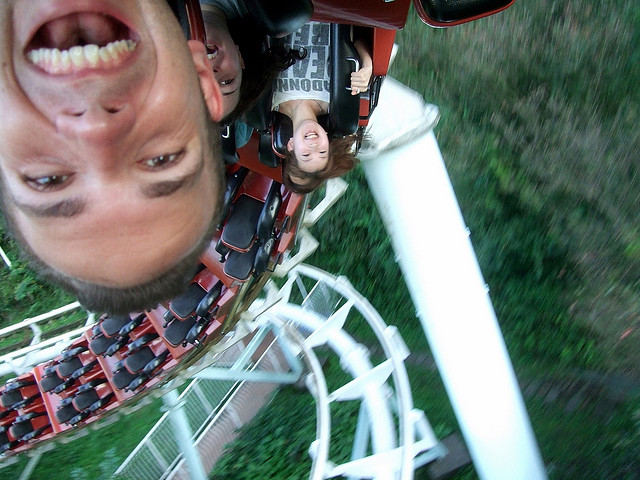The Santa Cruz Board Walk includes an old-fashioned rollercoaster ride named the Big Dipper. Establishing appropriate insurance requirements for transportation network companies (TNCs) such as Uber, Lyft, SideCar and Ride Share has been like a ride on the Big Dipper.
The California Public Utilities Commission (CPUC) has jurisdiction over TNCs as “charter party carriers” -- carriers for hire that, unlike taxis, must prearrange their rides. The Big Dipper ride began when the Consumer Protection and Safety Division of the CPUC sent cease-and-desist letters to some TNCs in 2010 and again in 2012. After studying insurance issues related to TNCs, in September 2013 the CPUC required TNCs to carry insurance providing as much as $1 million of coverage per incident while “providing TNC services.” This phrase proved to be troublesome.
There are three “periods” for TNC driving. Period One is when the driver turns on the TNC app (“log-on”) but does not yet have a match with a passenger. Period Two is when there is a match. Period Three is when a passenger is in the car. Although there is evidence in the record that the CPUC intended “providing TNC services” to cover all three periods, including Period One, it was not clearly stated in the rule. In addition, TNCs were uncomfortable extending $1 million in coverage to drivers merely because they were driving around while logged on.
Then came New Year’s Eve, 2013. An Uber driver killed a small child and injured the child’s mother and brother while driving during Period One. Because there was neither a passenger nor a match with a fare, it was possible that the driver was not “providing TNC services” and, therefore, was not covered by Uber’s insurance policy. It was likewise possible that the driver’s personal insurance would not apply.
Because the driver was logged on, the accident fell within the policy’s exclusion for commercial or livery use (although in this case the personal auto insurer provided coverage up to the policy’s limits). If neither Uber’s policy nor the personal policy covered the accident, the driver would have been uninsured -- an unacceptable outcome for the driver, the injured parties and public safety.
At least one TNC carried a “contingent” policy of $50,000 for an individual injury during Period One. The policy was triggered, however, only if the driver’s personal carrier declined coverage. This could lead to some odd results. If the driver had only $15,000 in coverage, and the driver’s carrier accepted responsibility, the injured pedestrian could look only to $15,000 in coverage. If the driver’s insurer declined to cover the accident, the pedestrian could look to the $50,000 coverage of the TNC policy.
In any event, there was no legal requirement that the TNC have coverage for Period One, and either $15,000 or $50,000 did not approach the $1 million the CPUC thought it had required. Following the New Year’s Eve accident, both the CPUC and the California legislature rushed to fill this possible “gap.”
The president of the CPUC proposed requiring a minimum of coverage of $100,000 for one injured person, $300,000 for more than one person and $50,000 for property damage (a 100/300/50 policy) of “excess” insurance for Period One, but the legislature arrived first. Although several bills were introduced, AB 2293 (Bonilla) is the only bill that made it to the finish line.
Initially, the bill sought only to build a “firewall” between personal insurance and TNC driving. The bill exempted personal auto insurance from covering driving while a TNC driver was logged on. Personal auto insurers argued that this driving is often more dangerous than ordinary personal driving, so, if personal auto insurers were responsible for the risk during Period One, the additional costs would be passed on to other auto owners. This might raise rates and would be a subsidy to commercial TNC enterprises.
The TNCs asked that their insurance limit during Period One be limited to 50/100/30, perhaps concerned that the CPUC wanted to require more coverage (recall that the CPUC was initially of the opinion that its $1 million requirement extended to Period One), To bolster their argument, the TNCs pointed to the limits adopted in a similar Colorado statute.
The bill in California was amended to include the 50/100/30 limit for Period One. Stakeholders pointed out that these limits were woefully inadequate to cover the injuries from the New Year’s Eve accident. The limits would also be inadequate to cover many other accidents.
The Bill was amended. Now, coverage for Period One would be $750,000 per incident (a 750/750/750 policy). This is the minimum coverage the CPUC has applied to limousines for 20 years or more. In addition, for losses exceeding $750,000 the TNC was to “assume all liability of the participating driver.” Liability, in effect, was limitless.
Now we are at the top of the ride. Hang on.
The TNCs were very unhappy with this turn of events. There was also concern whether such policies were available and, if so, affordable. TNCs are very popular with consumers, and few people wanted to appear to stifle this area of transportation innovation (with the exception, of course, of taxi drivers). The bill was amended again.
Period One coverage would now be 100/300/50, with $1 million of excess coverage. In addition, the drafters deleted the requirement that the TNC assume all of the driver’s liability. More lobbying, more horse trading and more diplomacy resulted in yet another amendment. The new limits were lowered to 50/100/30 (remember the limits in the Colorado law?), but with an excess policy of $500,000. It was unclear, however, whether the excess policy covered the driver or only the TNC.
With these lower limits, drivers might have found that their personal auto insurance would not cover them, yet their TNC coverage would be inadequate. This would put their personal assets at risk.
It occurred to the drafters that there was little point in adopting a bill unless the governor, who had not yet taken a position, would sign it. After consultation with the governor’s office, the bill was amended for the final time.
Period One maintained the minimum TNC coverage of 50/100/30, but the additional, excess policy was lowered from $500,000 to $200,000. The amendment also provided that the $200,000 excess policy must specifically cover the driver in addition to the TNC. The bill carried forward earlier requirements for Periods Two and Three. The bill requires $1 million in liability coverage for Periods Two and Three and requires $1 million in uninsured/underinsured motorist coverage for Period Three.
The bill directs the Department of Insurance to collaborate on a data-based study and report back to the legislature. To allow insurers time to create policies or endorsements to cover all of these requirements, the new limits are to take effect on July 1, 2015. If one is to be injured by a TNC driver during Period One, it may be best to consider postponing the injury until then.
The final bill also did something else. During final amendments, two words were added -- “at least.” Period One coverage, including the $200,000 excess coverage, must be “at least” those limits set out above. Because AB 2293 specifically permits the CPUC to continue exercising its rulemaking authority “in a manner consistent with” AB 2293, if the CPUC were to adopt higher limits (for instance, the $750,000 limit it applies to limousines), these limits would be “consistent” with limits “at least” those outlined above.
So we complete our first Big Dipper ride where we began -- with the CPUC. Two words -- “at least” -- are the CPUC’s ticket to reboard the Big Dipper. When the time is right, perhaps there will be yet another dizzying ride.
Please lower the bar snugly across your lap and keep your hands and feet inside.








